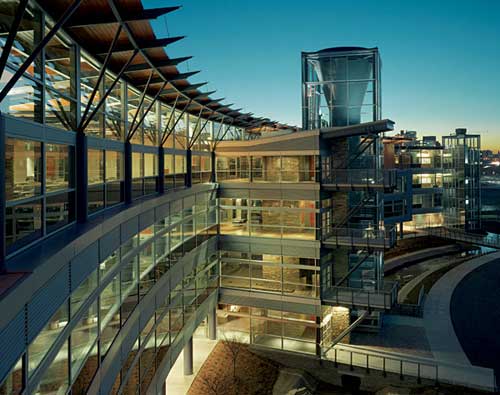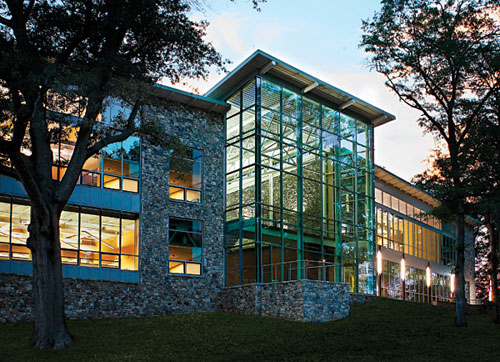Daylight Savings: Window Systems Deliver Light and Reduced Energy Costs
Low-E Glass and How it Works
Traditionally, architects have relied on tinted or highly reflective products to achieve energy performance. Even energy-wasting single-glazed, clear float glass has a shading coefficient of .86. Most designers have had to choose between a variety of dark tinted glazing to achieve desired energy savings. The allure of a glass that is neutral in color with natural light transmittance and without the heat and glare is strong.
The glass industry responded with high-performance Low-E products that use a super-thin metallic coating to allow natural light in while reducing heat transfer. Emissivity is the measure of the glass's ability to radiate energy, and the lower the emissivity, the less heat is transferred in or out. "Low-E glass is becoming more common on projects today," says Zeimetz.
Low-E products are continually evolving. The newest generation of Low-E technologies is spectrally selective coatings that filter between 40 to 70 percent of solar radiation normally transmitted through clear glass, while still allowing in large amounts of light. Advanced glazings with spectrally selective coatings can reduce cooling requirements hot climates by some 40 percent.
Two spectrally selective Low-E options are sputter-coated (also known as soft coat) glass, and pyrolytic-coated (also known as hard coat) glass. To create sputter Low-E coatings, optically transparent silver is deposited on the float glass off-line, after the base glass is manufactured. Sputter low-E includes one or more layers of silver between layers of metal oxide in a vacuum. Pyrolytic Low-E is produced by applying metal oxides during the molten stage of float glass manufacturing. Sputter-coated glass provides high visible light transmission and optimal transparency, and dramatically lowers heat gain or loss, while pyrolytic Low-E coatings typically allow more solar heat to be transmitted than the latest generation of sputter-coated glass.
 |
Insulated Low-E glass was the choice for Heifer International Headquarters in Little Rock, AR. Photography: Timothy Hursley; Photo courtesy of Guardian Industries Corp. |
Â
Manufacturers offer improvements over the standard, widely used commercial spectrally selective Low-E glass with solar heat gain coefficients (SHGC) as low as 0.28. Given the same U values, decreasing the SHGC from the .37 of the standard commercial Low-E glass to .28, and the visible light transmittance from 67 percent to 54 percent adds up to significant savings.
An independent study by engineering company Enermodal Engineering Inc. pegs the potential savings generated by the lower SHCG glass at as much as $2.50 a square foot due to downsizing the chilled water and air distribution systems. And when compared to traditional high-performance Low-E glass, operational costs savings of up to $1.60 per foot of glass can be achieved by the newer glass in buildings with glare and daylighting controls. The glass effectively blocks 72 percent of solar energy, while transmitting 54 percent of natural light. "That's about the right amount of light for a building interior," says Dolan. "And the cost differential over standard high-performance Low-E glass can be measured in pennies."
 |
The Western Carolina Regional Sewer Authority headquarters features the latest in spectrally selective Low-E glass. Photo courtesy of Firewater Photography, LLC |









